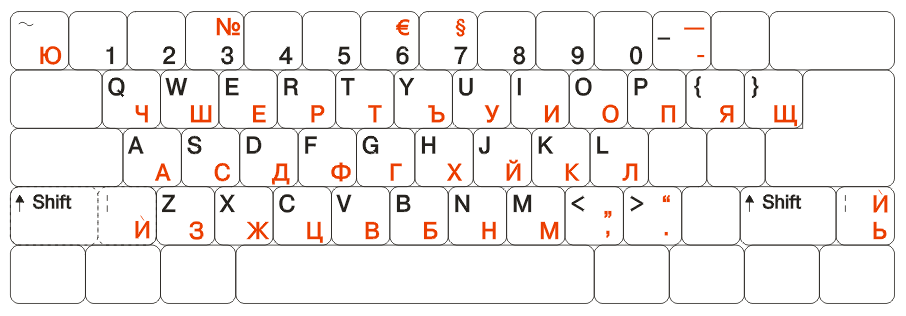So, I gave the Bulgarian variant another thought. It seems to me that the common Bulgarian phonetic layouts have a few unnecessary differences from the other Cyrillic phonetic layouts?

"Bulgarian phonetic layout", Wikimedia commons – the basis for 'Bulmak' that user Ghoul posted:
Ghoul said:Here's my Bulmak
ч 1 2 3 4 5 6 7 8 9 0 - =
я в ф п г й л у ъ ; ш щ ю
а р с т д х н е и о '
з ь ц ж б к м , . /
[EDIT: But see below for an updated Bulmak!]

The "new phonetic" Bulgarian layout (here from Methodius.org)
Apparently, the "new phonetic" ЧШЕРТЪ layout is an attempted standard (BDS 2006) that may have failed in practice but is found both in Windows and Linux. The ЯВЕРТЪ phonetic layout is the most popular layout in Bulgaria and the non-phonetic BDS layout less used. That's an argument for going with Ghoul's "Bulmak" directly. Some thoughts:
- Frequencywise in relation to Russian, ъ is more common (17.1‰!) and ю less (1.1‰); ь is very rare (0.1‰), э hardly used and ы/ё not used in Bulgarian.
- The Bulgarians like to reclaim the ; and ' keys and I agree with that!
- I'd like to harmonize with the Rulemak setup for the XH keys. I realize that 'х' is romanized to 'h' and it's on the H in some existing phonetic layouts.
- I fear that the Bulgarians would not accept the solution of 'ha' on X; there are thus arguments for either XH mapping but the traditional one should win!
- Putting ч away in the upper corner is odd since it's not all that uncommon (14.4‰)?! It probably deserves being on H or X.
- The э could just stay on '\', as Rulemak already puts it out of the highway? Probably on lv3-4 though.
- As ь is so rare, a lv1-2/lv3-4 swap from Rulemak should be in order (ь Ь ' " → ' " ь Ь); that's consistent in my view.
- I should think that ё can be typed with the diaeresis dead key plus 'е', for the rare occasion that a Bulgarian needs it.
- Losing ы, the Y key is free to hold ъ which is the way Bulgarians prefer it. ы could go to lv3-4 of the semicolon key?
- Then, the odd one out is ю which is stuck on the tilde key. This conforms with the "new phonetic" layout (and YaWERTY...).
- Bulgarian also uses Ǹ (U045D/U040D) on some layouts, an I variant. How common is it? Does it deserve a separate place, or is the grave dead key okay for it?
- In the xkb phonetic layouts there are several other glyphs (U0463/U0462 Ѣ, U046B/U046A Ѫ, U046D/U046C Ѭ); these are obsolete so I hope we can do without.
Do these thoughts make sense, or is there something I'm not aware of? This way, Rulemak and 'Bulgemak' would be more consistent with each other.

The Colemak phonetic layout for Bulgarian Kyrillic script – my take. See the locale Colemak topic.
Last edited by DreymaR (08-Jan-2016 12:08:30)






